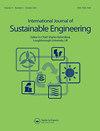Mechanical, wear and thermal conductivity characteristics of snail shell-derived hydroxyapatite reinforced epoxy bio-composites for adhesive biomaterials applications
IF 3.6
Q3 GREEN & SUSTAINABLE SCIENCE & TECHNOLOGY
International Journal of Sustainable Engineering
Pub Date : 2022-06-06
DOI:10.1080/19397038.2022.2084174
引用次数: 2
Abstract
ABSTRACT This research investigates the effects of snail shell-based hydroxyapatite (HAp) reinforcements on the mechanical, wear, and selected physical properties of epoxy-based composites. The exploitation of these properties was aimed at assessing the suitability and efficiency of the developed bio-composites for adhesive biomedical applications. Snail shell wastes were sourced and processed to obtain (HAp) particles of ˂20 μm. The bio-derived hydroxyapatite-based epoxy composites were produced using the stir-cast method by mixing the hydroxyapatite with the epoxy resin and hardener before pouring into the moulds where they are allowed to cure. Scanning Electron Microscope (SEM) and X-ray Diffraction (XRD) of the snail shell hydroxyapatite particles were carried out while mechanical, wear, and physical properties of the developed composites were evaluated. SEM images of the fracture surfaces were also examined. The results showed that enhancements occurred from the addition of snail shell-derived HAp to epoxy resin in the developed composites. The results revealed that most of the properties gave their optimum values when 15 wt.% reinforcement was used. At this weight fraction, optimum values were obtained which include 43 MPa for maximum flexural strength, 40HS for hardness, 40 J for impact, 0.35 W/mK for thermal conductivity, and 0.07 for wear index.蜗牛壳羟基磷灰石增强环氧生物复合材料的力学、磨损和导热特性
摘要本研究探讨了螺壳基羟基磷灰石(HAp)增强材料对环氧基复合材料力学性能、磨损性能和选定物理性能的影响。这些性能的开发旨在评估所开发的生物复合材料用于粘合剂生物医学应用的适用性和效率。对蜗牛壳废料进行来源和处理,以获得20μm的(HAp)颗粒。生物衍生的羟基磷灰石基环氧复合材料是使用搅拌铸造法生产的,在倒入模具中固化之前,将羟基磷灰石与环氧树脂和硬化剂混合。对螺壳羟基磷灰石颗粒进行了扫描电子显微镜(SEM)和X射线衍射(XRD),并对所开发的复合材料的力学性能、磨损性能和物理性能进行了评价。还检查了断裂表面的SEM图像。结果表明,在所开发的复合材料中,在环氧树脂中添加蜗牛壳衍生的HAp会产生增强作用。结果表明,当使用15wt%的增强剂时,大多数性能都达到了最佳值。在该重量分数下,获得了最佳值,包括最大弯曲强度43MPa、硬度40HS、冲击40J、热导率0.35W/mK和磨损指数0.07。
本文章由计算机程序翻译,如有差异,请以英文原文为准。
求助全文
约1分钟内获得全文
求助全文
来源期刊

International Journal of Sustainable Engineering
GREEN & SUSTAINABLE SCIENCE & TECHNOLOGY-
CiteScore
7.70
自引率
0.00%
发文量
19
 求助内容:
求助内容: 应助结果提醒方式:
应助结果提醒方式:


